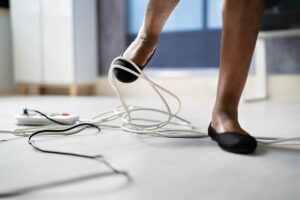Sometimes conventional wisdom, even if it comes from a trusted source can be deadly—especially if it pertains to electrical safety. This is one time that checking facts just might save your life.
Since you probably won’t be in a position to fact check in an emergency situation, now is the time to learn the difference between myth and reality when it comes to electrical safety, so that you can practice the proper procedures if and when the time comes. Don’t forget to teach what you learn to others, especially the young people in your life.
Here are some common electrical safety myths and the truth behind them:
MYTH – A downed power line will be arcing and smoking if it still has power.
FACT – Power lines do not automatically shut off when they fall and do not necessarily arc, flash, pop or smoke when they hit the ground. There is no way to know for sure if a line has potentially deadly current running through it unless it has been properly discharged by a utility crew, so stay away from all downed power lines and keep others away.
MYTH – Household current cannot kill you.
FACT – Household current can and does kill. Case-in-point, 10-year-old Caitlyn Mackenzie was killed by household current when she touched a lamp while still damp from a swimming pool. You can see Caitlyn’s story at SafeElectricity.org.
MYTH – Power lines are insulated.
FACT – The majority of outside power lines are not insulated. The coating you might see on some lines is just weatherproofing that will offer no protection from the electricity flowing through the lines.
MYTH – Light digging in the yard won’t be deep enough to hit any wires or pipes.
FACT – Unless you call 811 and have a professional come to your home and locate the utilities, you can never be sure where lines and pipes are buried. Even if you are just planting flowers or a shrub, you might come into contact with power lines that could kill you. Keep in mind that the locations they mark are approximate, so if you are digging near one of the marked lines, do so with caution. Find out how dangerous underground digging can be by watching Tom’s story at SafeElectricity.org.
MYTH – Tires insulate my car from electrical dangers.
FACT – If a wire falls on your car while you are in it, the tires are not keeping you from being injured by the electricity. You are not being hurt because you are not a path to ground for the electricity—as long as you stay in the car. Once you step out of the car, you become that path to ground and can be seriously injured or killed. If you find yourself in a situation where your car has hit a utility pole or has a power line come down on it, the best place for you to be is in the car. Call for help, and keep others away until a utility crew can de-energize the wires. If you must exit the car, it is critical for you to make sure not to touch the ground and the car at the same time. Jump out of the car, keeping your feet together. Then bunny-hop away. I know doing a bunny hop with your feet together might sound ridiculous, but it could literally save your life. Find out more by watching Safety Expert Kyle Finley’s Live Line Demonstration at www.youtube.com/SafeElectricity.
These are just some of the myths that can get you killed. When it comes to electricity you cannot take chances. You have to be prepared and make sure that your family and friends know how to work and live safely around electricity.
To find out more about keeping your family safe from electrical hazards, go to SafeElectricity.org.
Molly Hall is Director of Safe Electricity. E-mail molly-hall@SafeElectricity.org. Safe Electricity is a public awareness program of the Energy Education Council. www.EnergyEdCouncil.org.







